Continental Shale Oil Reservoir Lithofacies Identification and Classification with Logging Data—A Case Study from the Bohai Bay Basin, China
Abstract
1. Introduction
2. Continental Shale Oil Reservoir Lithofacies Characteristics
2.1. Mineral Component Characteristics
2.2. Sedimentary Structural Characteristics
2.3. Criteria for Lithological Identification and Classification
3. Fine Identification Methods of Lithofacies Logging
3.1. Mineral Composition Calculation
3.2. Sedimentary Structure Identification
4. Application Examples
5. Conclusions
Author Contributions
Funding
Institutional Review Board Statement
Data Availability Statement
Conflicts of Interest
References
- Li, G.; Liu, G.; Hou, Y.; Zhao, X.; Wu, J.; Li, S.; Xian, C.; Liu, H. Optimization method of favorable lithofacies and fracturing parameter for continental shale oil. Acta Pet. Sin. 2021, 42, 1405–1416. [Google Scholar] [CrossRef]
- Carvajal-Ortiz, H.; Gentzis, T.; Ostadhassan, M. Sulfur Differentiation in Organic-Rich Shales and Carbonates via Open-System Programmed Pyrolysis and Oxidation: Insights into Fluid Souring and H2S Production in the Bakken Shale, United States. Energy Fuels 2021, 35, 12030–12044. [Google Scholar] [CrossRef]
- Zou, C.; Zhu, R.; Bai, B.; Yang, Z.; Hou, L.; Zha, M.; Fu, J.; Shao, Y.; Liu, K.; Cao, H. Significance, Geologic Characteristics, Resource Potential and Future Challenges of Tight Oil and Shale Oil. Bull. Mineral. Petrol. Geochem. 2015, 34, 3–17. [Google Scholar] [CrossRef]
- Taghavinejad, A.; Sharifi, M.; Heidaryan, E.; Liu, K.; Ostadhassan, M. Flow modeling in shale gas reservoirs: A comprehensive review. J. Nat. Gas Sci. Eng. 2020, 83, 103535. [Google Scholar] [CrossRef]
- Li, N.; Feng, Z.; Wu, H.; Tian, H.; Liu, P.; Liu, Y.; Liu, Z.; Wang, K.; Xu, B. New advances in methods and technologies for well logging evaluation of continental shale oil in China. Acta Pet. Sin. 2023, 44, 28–44. [Google Scholar] [CrossRef]
- Chen, Z.; Jiang, C. An integrated mass balance approach for assessing hydrocarbon resources in a liquid-rich shale resource play: An example from upper devonian Duvernay formation, western Canada sedimentary basin. J. Earth Sci. 2020, 31, 1259–1272. [Google Scholar] [CrossRef]
- Basu, S.; Jones, A.; Mahzari, P. Best practices for shale core handling: Transportation, sampling and storage for conduction of analyses. J. Mar. Sci. Eng. 2020, 8, 136. [Google Scholar] [CrossRef]
- Day-Stirrat, R.J.; Hillier, S.; Nikitin, A.; Hofmann, R.; Mahood, R.; Mertens, G. Natural gamma-ray spectroscopy (NGS) as a proxy for the distribution of clay minerals and bitumen in the Cretaceous McMurray Formation, Alberta, Canada. Fuel 2021, 288, 119513. [Google Scholar] [CrossRef]
- Liu, B.; Shi, J.; Fu, X.; Lyu, Y.; Sun, X.; Gong, L.; Bai, Y. Petrological characteristics and shale oil enrichment of lacustrine fine-grained sedimentary system: A case study of organic-rich shale in first member of Cretaceous Qingshankou Formation in Gulong Depression, Songliao Basin, NE China. Pet. Explor. Dev. 2018, 45, 828–838. [Google Scholar] [CrossRef]
- Liu, B.; Sun, J.; Zhang, Y.; He, J.; Fu, X.; Yang, L.; Xing, J.; Zhao, X. Reservoir space and enrichment model of shale oil in the first member of Cretaceous Qingshankou Formation in the Changling Depression, southern Songliao Basin, NE China. Pet. Explor. Dev. 2021, 48, 521–535. [Google Scholar] [CrossRef]
- Kumar, S.; Das, S.; Bastia, R.; Ojha, K. Mineralogical and morphological characterization of older Cambay shale from North Cambay Basin, India: Implication for shale oil/gas development. Mar. Pet. Geol. 2018, 97, 339–354. [Google Scholar] [CrossRef]
- Körmös, S.; Varga, A.; Raucsik, B. Reservoir heterogeneity of an Eocene mixed siliciclastic-carbonate succession, northern Pannonian Basin. Mar. Pet. Geol. 2023, 147, 105984. [Google Scholar] [CrossRef]
- Haluch, A.; Rybak-Ostrowska, B.; Wygladala, M. Interplay of organic matter, rock anisotropy, and horizontal shortening in bed-parallel vein development within the lower Palaeozoic shale formations from the northern part of the Caledonian Foredeep Basin (Poland). Mar. Pet. Geol. 2023, 155, 106387. [Google Scholar] [CrossRef]
- Liu, H.; Yu, B.; Xie, Z.; Han, S.; Shen, Z.; Bai, C. Characteristics and implications of micro-lithofacies in lacustrine- basin organic-rich shale: A case study of Jiyang depression, Bohai Bay Basin. Acta Pet. Sin. 2018, 39, 1328–1343. [Google Scholar] [CrossRef]
- Liu, H.; Wang, Y.; Yang, Y.; Zhang, S. Sedimentary Environment and Lithofacies of Fine-Grained Hybrid Sedimentary in Dongying Depression: A Case of Fine-Grained Sedimentary System of the Es4. Earth Sci. 2020, 45, 3543–3555. [Google Scholar] [CrossRef]
- Bhattacharya, S.; Carr, T.R. Integrated Data-Driven 3D Shale Lithofacies Modeling of the Bakken Formation in the Williston Basin, North Dakota, United States. J. Pet. Sci. Eng. 2019, 177, 1072–1086. [Google Scholar] [CrossRef]
- Bhattacharya, S.; Carr, T.R.; Pal, M. Comparison of Supervised and Unsupervised Approaches for Mudstone Lithofacies Classification: Case Studies from the Bakken and Mahantango-Marcellus Shale, USA. J. Nat. Gas Sci. Eng. 2016, 33, 1119–1133. [Google Scholar] [CrossRef]
- Bressan, T.S.; Kehl De Souza, M.; Girelli, T.J.; Junior, F.C. Evaluation of Machine Learning Methods for Lithology Classification Using Geophysical Data. Comput. Geosci. 2020, 139, 104475. [Google Scholar] [CrossRef]
- Li, Z.; Tang, X.; Huang, L.; Chang, Q.; Yang, L.; Yang, R. Lithofacies development characteristics of Fengcheng Formation shale in Mahu Depression, Junggar Basin. China Energy Environ. Prot. 2021, 43, 108–114. [Google Scholar] [CrossRef]
- Liu, Z.; Liu, G.; Hu, Z.; Feng, D.; Zhu, T.; Bian, R.; Jiang, T.; Jin, Z. Lithofacies types and assemblage features of continental shale strata and their sig- nificance for shale gas exploration: A case study of the Middle and Lower Jurassic strata in the Sichuan Basin. Nat. Gas Ind. 2019, 39, 10–21. [Google Scholar]
- Zhu, X.; Duan, H.; Sun, Y. Breakthrough and significance of Paleogene continental shale oil exploration in Gaoyou Depression, Subei Basin. Acta Pet. Sin. 2023, 44, 1206–1221. [Google Scholar] [CrossRef]
- Avanzini, A.; Balossino, P.; Brignoli, M.; Spelta, E.; Tarchiani, C. Lithologic and geomechanical facies classification for sweet spot identification in gas shale reservoir. Interpretation 2016, 4, SL21–SL31. [Google Scholar] [CrossRef]
- Ehsan, M.; Gu, H. An integrated approach for the identiBcation of lithofacies and clay mineralogy through Neuro-Fuzzy, cross plot, and statistical analyses, from well log data. J. Earth Syst. Sci. 2020, 129, 101. [Google Scholar] [CrossRef]
- Santos, D.T.D.; Roisenberg, M.; Nascimento, M.D.S. Deep Recurrent Neural Networks Approach to Sedimentary Facies Classifica tion Using Well Logs. IEEE Geosci. Remote Sens. Lett. 2022, 19, 3001405. [Google Scholar] [CrossRef]
- Liu, G. Challenges and countermeasures of well logging data acquisition technology in unconventional petroleum exploration and development. China Pet. Explor. 2021, 26, 24–37. [Google Scholar]
- Liu, S.; Cao, Y.; Liang, C. Lithologic characteristics and sedimentary environment of fine-grained sedimentary rocks of the Paleogene in Dongying Depression, Bohai Bay Basin. J. Palaeogeogr. (Chin. Ed.) 2019, 21, 479–489. [Google Scholar] [CrossRef]
- Liu, H.; Sun, S.; Cao, Y.; Cao, Y.; Liang, C.; Zhang, C. Lithofacies characteristics and distribution model of fine-grained sedimentary rock in the lower Es3 member, Dongying Depression. Pet. Geol. Recovery Effic. 2017, 24, 1–10. [Google Scholar]
- Zhou, L.; Pu, X.; Deng, Y.; Chen, S.; Yan, J.; Han, W. Several issues in studies on fine-grained sedimentary rocks. Lithol. Reserv. 2016, 28, 6–15. [Google Scholar]
- Jarvie, D.M. Shale resource systems for oil and gas: Part 2—Shale-oil resource systems. AAPG Mem. 2012, 97, 89–119. [Google Scholar]
- Liu, G.; Zhao, X.; Yuan, C.; Li, S.; Liu, Z. Logging evaluation of macro-structure of continental shale oil reservoir and sweet spots selection. China Pet. Explor. 2023, 28, 120–134. [Google Scholar]
- Cavelan, A.; Boussafir, M.; Milbeau, C.L.; Fatima, L. Impact of oil-prone sedimentary organic matter quality and hydrocarbon generation on source rock porosity: Artificial thermal maturation approach. ACS Omega 2020, 5, 14013–14029. [Google Scholar] [CrossRef] [PubMed]
- Yan, J.; Pu, X.; Zhou, L.; Chen, S.; Han, W. Naming Method of Fine-grained Sedimentary Rocks on Basis of X-ray Diffraction Data. China Pet. Explor. 2015, 20, 48–54. [Google Scholar] [CrossRef]
- Liu, G. Challenges and countermeasures of log evaluation in unconventional petroleum exploration. Pet. Explor. Dev. 2021, 48, 891–902. [Google Scholar] [CrossRef]
- Li, N.; Yan, W.; Wu, H.; Zheng, J.; Feng, Z.; Zhang, Z.; Wang, K.; Wang, J. Current situation, problems and countermeasures of the well-logging evaluation technology for Gulong shale oil. Pet. Geol. Oilfield Dev. Daqing 2020, 39, 117–128. [Google Scholar] [CrossRef]
- Hakimi, M.; Ahmed, A. Petroleum source rock characterisation and hydrocarbon generation modeling of the Cretaceous sediments in the Jiza sub-basin, eastern Yemen. Mar. Petrol. Geol. 2016, 75, 356–373. [Google Scholar] [CrossRef]
- Kumar, A.; Laronga, R.; Kherroubi, J.; Bringer, F.; Kear, G.; Herrera, J. Visualizing Borehole Images in a Slabbed-Core Format; EAGE: Dubai, United Arab Emirates, 2014. [Google Scholar]
- Cui, B.; Chen, C.; Lin, X.; Zhao, Y.; Chen, X.; Zhang, Y.; Lu, G. Characteristics and distribution of sweet spots in Gulong shale oil reservoirs of Songliao Basin. Pet. Geol. Oilfield Dev. Daqing 2020, 39, 45–55. [Google Scholar] [CrossRef]
- Du, J.; Hu, S.; Pang, Z.; Lin, S.; Hou, L.; Zhu, R. The types, potentials and prospects of continental shale oil in China. China Pet. Explor. 2019, 24, 560–568. [Google Scholar] [CrossRef]
- Wu, J.; Li, H.; Yang, X.; Zhao, S.; Guo, W.; Sun, Y.; Liu, Y.; Liu, Z. Types and combinations of deep marine shale laminae and their effects on reservoir quality: A case study of the first submember of member 1 of Longmaxi Formation in Luzhou block, South Sichuan Basin. China Pet. Acta Petrolei Sinica. 2023, 44, 1517–1531. [Google Scholar]
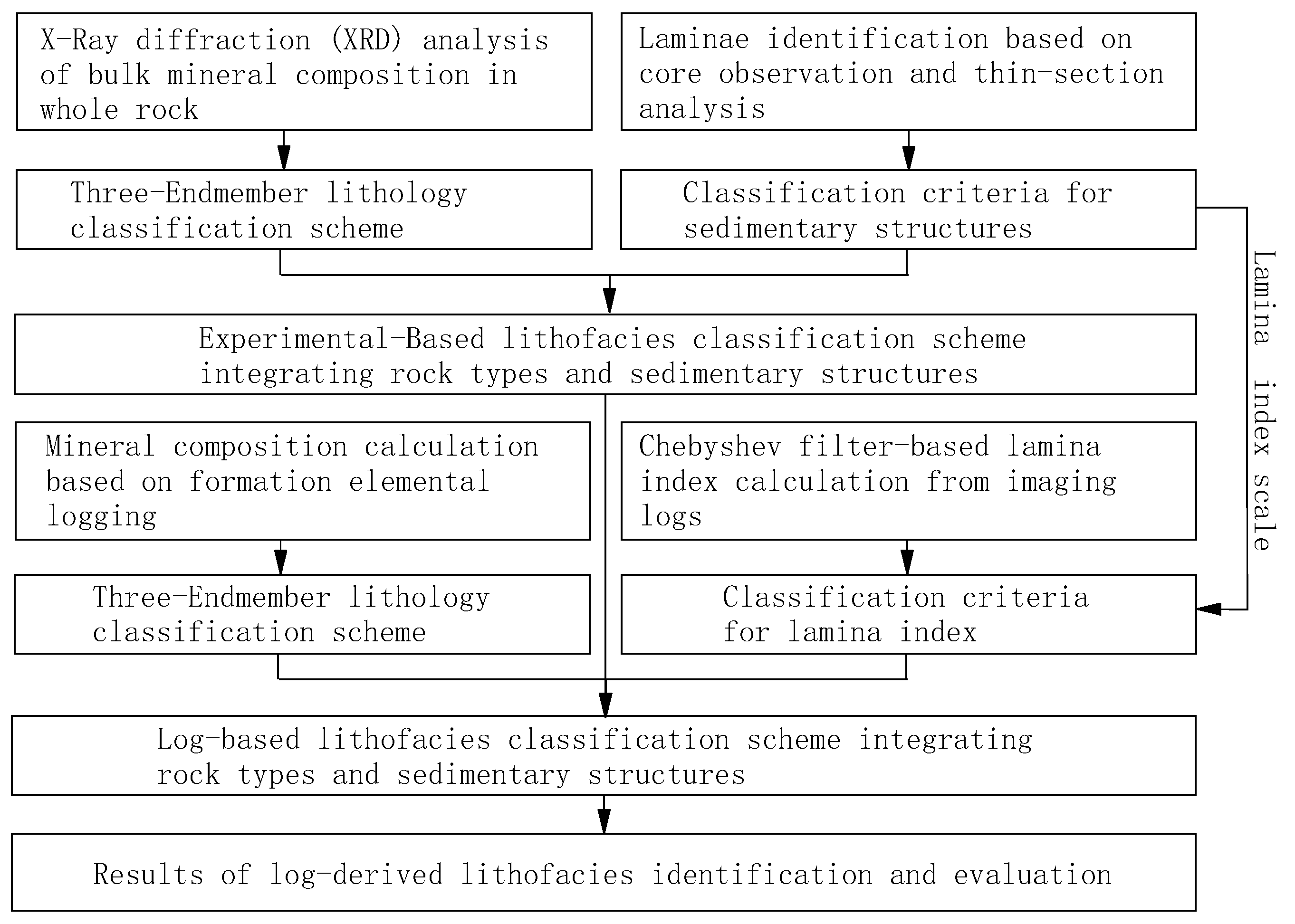
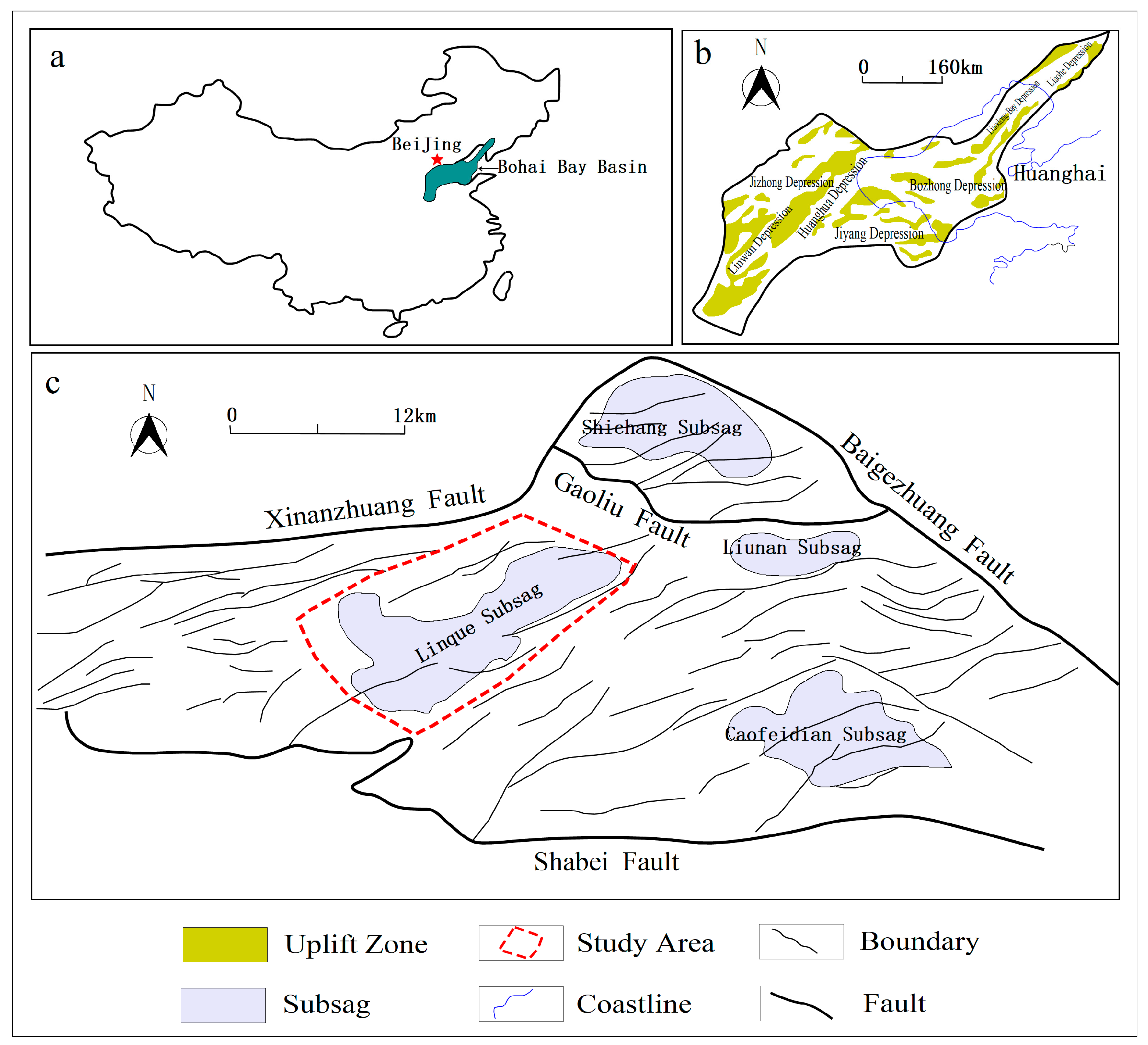

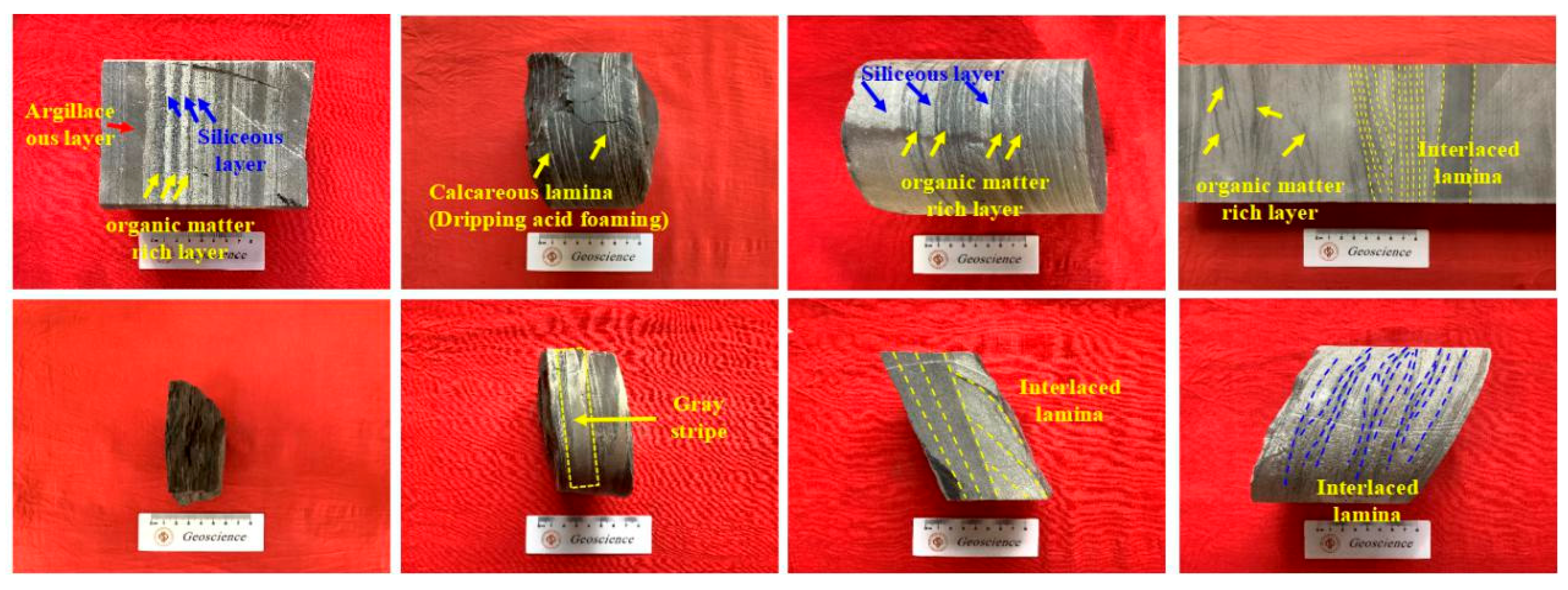



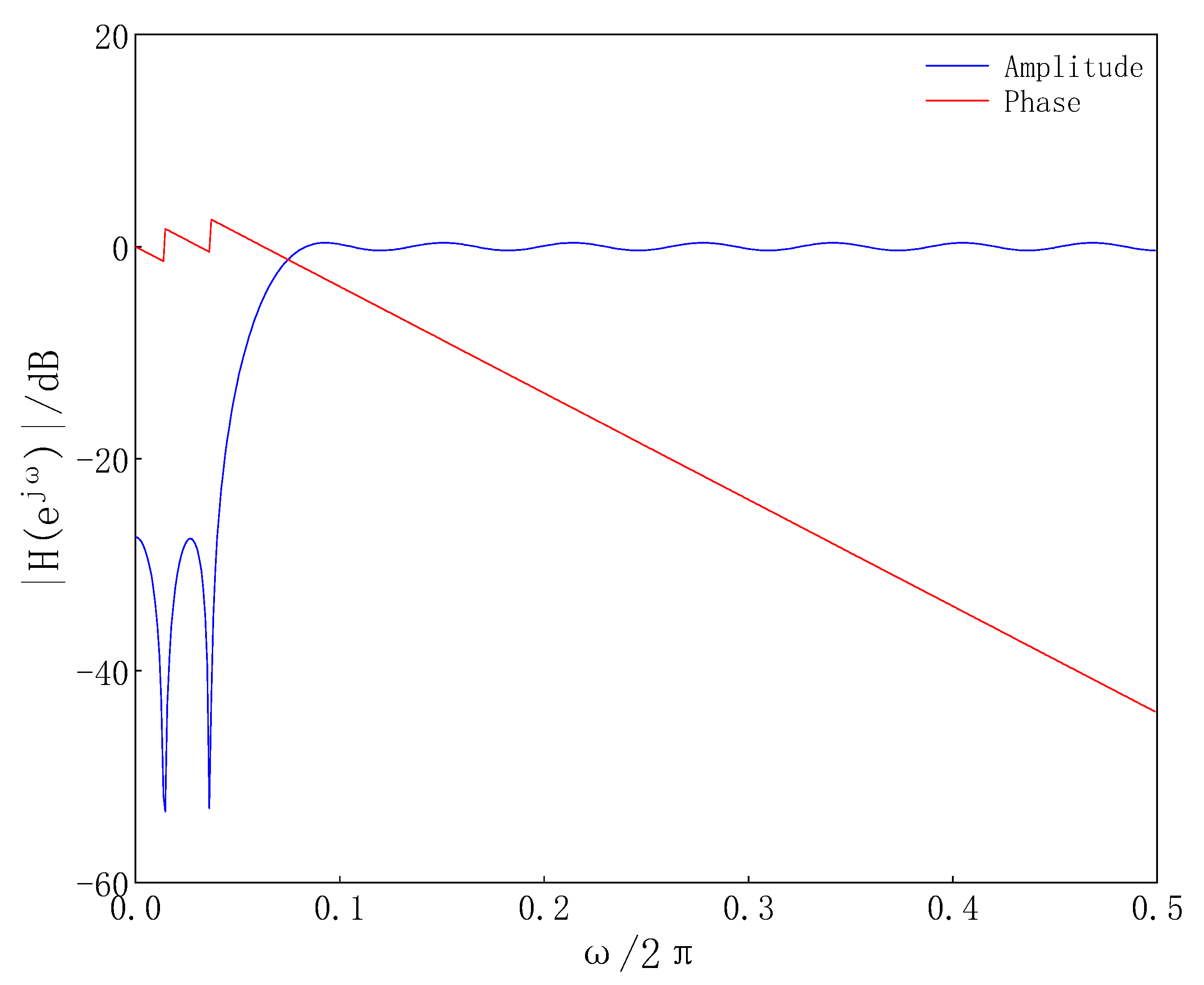
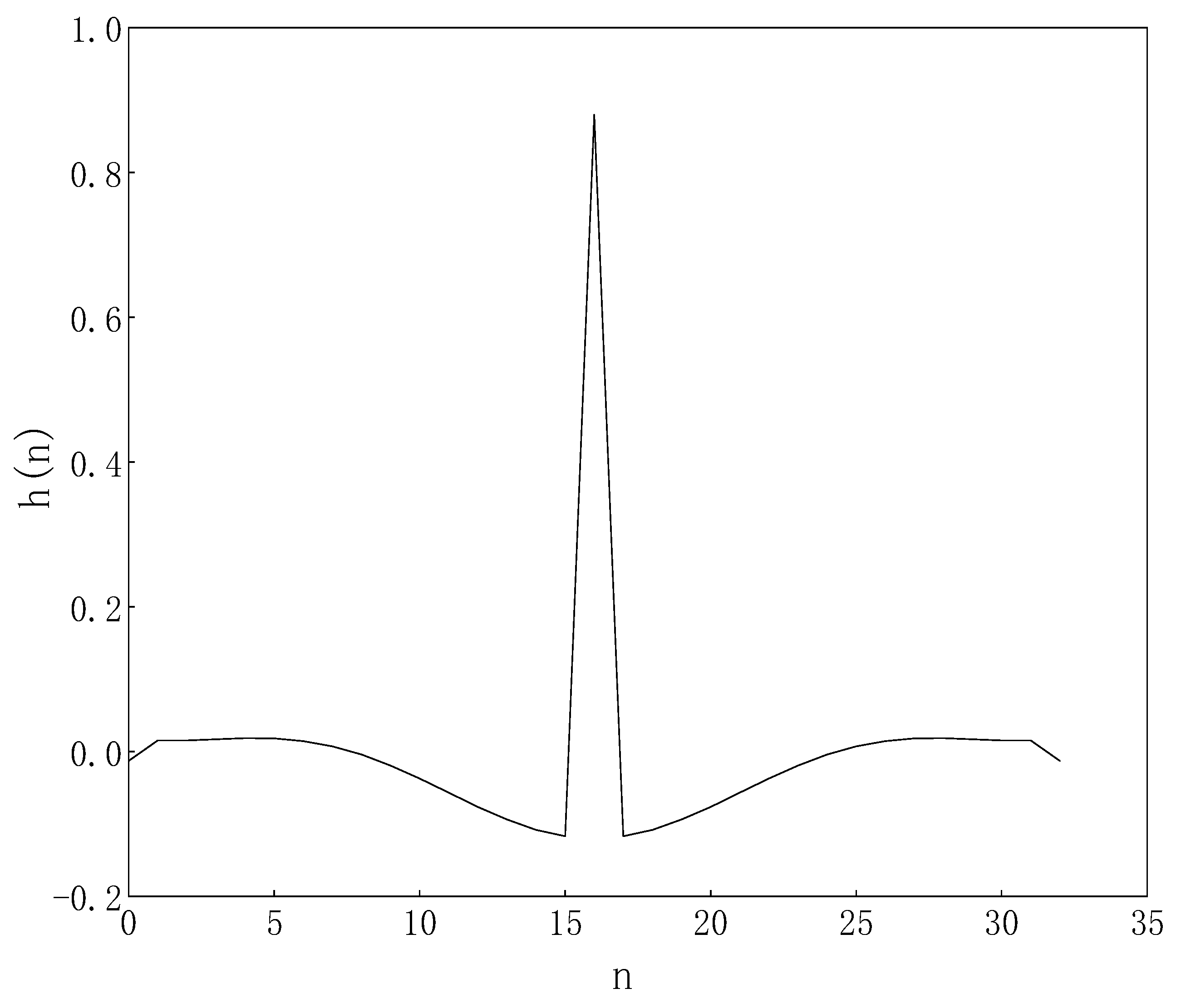

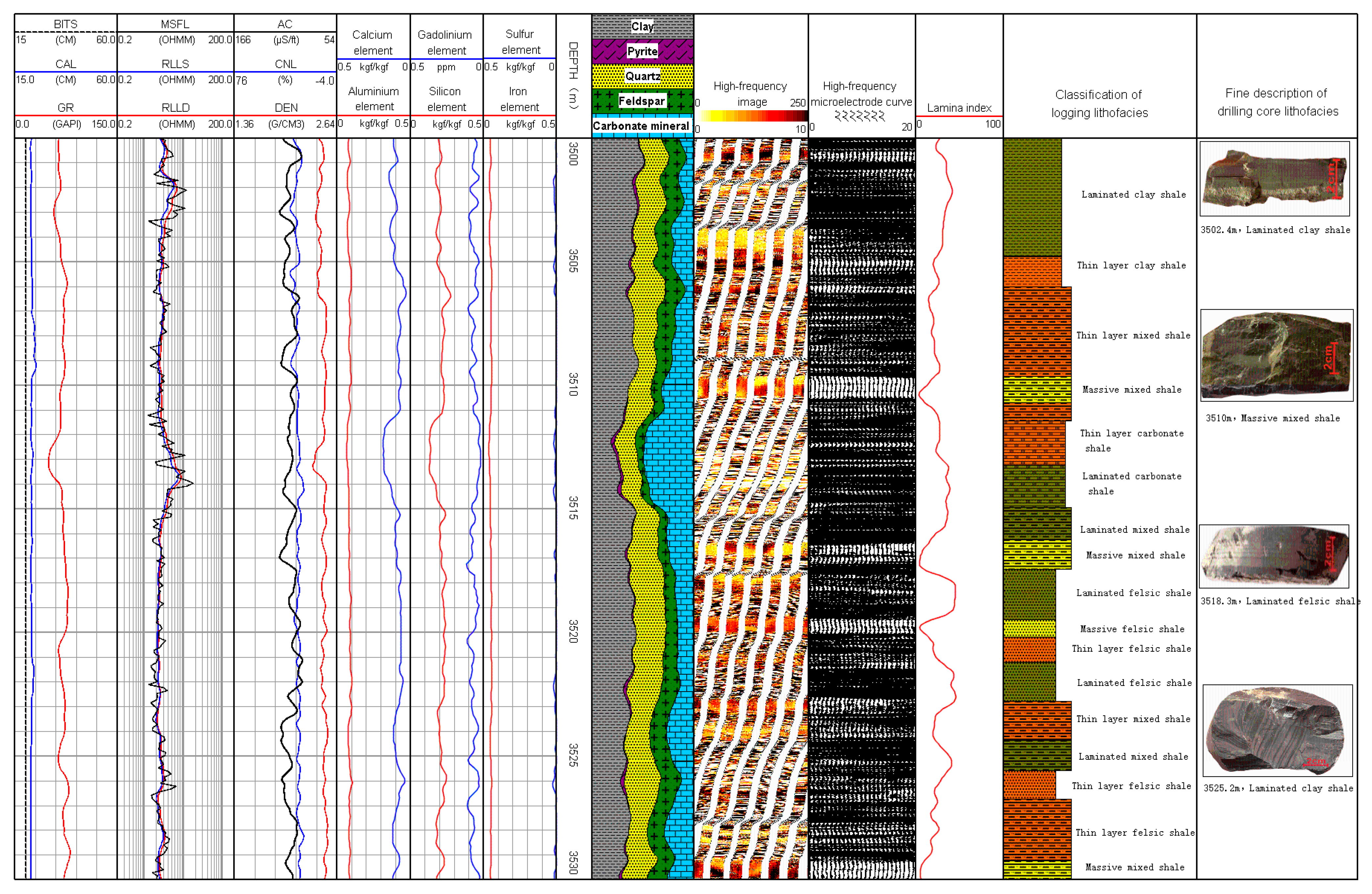
| Type of Rock | Mineral Component Content (%) | Sedimentary Structure (mm) | Lamination Index | ||
|---|---|---|---|---|---|
| Quartz + Feldspar | Calcite + Dolomite | Clay. | |||
| Laminated felsic shale | ≥50 | <50 | <50 | <1 | >30 |
| Thin layer felsic shale | ≥50 | <50 | <50 | 1 ≤ && ≤ 10 | 10 ≤ && ≤ 30 |
| Massive felsic shale | ≥50 | <50 | <50 | >10 | <10 |
| Laminated carbonate shale | <50 | ≥50 | <50 | <1 | >30 |
| Thin layer carbonate shale | <50 | ≥50 | <50 | 1 ≤ && ≤ 10 | 10 ≤ && ≤ 30 |
| Massive carbonate shale | <50 | ≥50 | <50 | >10 | <10 |
| Laminated clay shale | <50 | <50 | ≥50 | <1 | >30 |
| Thin layer clay shale | <50 | <50 | ≥50 | 1 ≤ && ≤ 10 | 10 ≤ && ≤ 30 |
| Massive clay shale | <50 | <50 | ≥50 | >10 | <10 |
| Laminated mixed shale | <50 | <50 | <50 | <1 | >30 |
| Thin layer mixed shale | <50 | <50 | <50 | 1 ≤ && ≤ 10 | 10 ≤ && ≤ 30 |
| Massive mixed shale | <50 | <50 | <50 | >10 | <10 |
Disclaimer/Publisher’s Note: The statements, opinions and data contained in all publications are solely those of the individual author(s) and contributor(s) and not of MDPI and/or the editor(s). MDPI and/or the editor(s) disclaim responsibility for any injury to people or property resulting from any ideas, methods, instructions or products referred to in the content. |
© 2025 by the authors. Licensee MDPI, Basel, Switzerland. This article is an open access article distributed under the terms and conditions of the Creative Commons Attribution (CC BY) license (https://creativecommons.org/licenses/by/4.0/).
Share and Cite
Liang, Z.; Li, X.; Zhou, H.; Meng, L.; Sun, A.; Wu, Q.; Wen, H. Continental Shale Oil Reservoir Lithofacies Identification and Classification with Logging Data—A Case Study from the Bohai Bay Basin, China. Minerals 2025, 15, 484. https://doi.org/10.3390/min15050484
Liang Z, Li X, Zhou H, Meng L, Sun A, Wu Q, Wen H. Continental Shale Oil Reservoir Lithofacies Identification and Classification with Logging Data—A Case Study from the Bohai Bay Basin, China. Minerals. 2025; 15(5):484. https://doi.org/10.3390/min15050484
Chicago/Turabian StyleLiang, Zhongkui, Xueying Li, He Zhou, Lingjian Meng, Aiyan Sun, Qiong Wu, and Huijian Wen. 2025. "Continental Shale Oil Reservoir Lithofacies Identification and Classification with Logging Data—A Case Study from the Bohai Bay Basin, China" Minerals 15, no. 5: 484. https://doi.org/10.3390/min15050484
APA StyleLiang, Z., Li, X., Zhou, H., Meng, L., Sun, A., Wu, Q., & Wen, H. (2025). Continental Shale Oil Reservoir Lithofacies Identification and Classification with Logging Data—A Case Study from the Bohai Bay Basin, China. Minerals, 15(5), 484. https://doi.org/10.3390/min15050484





